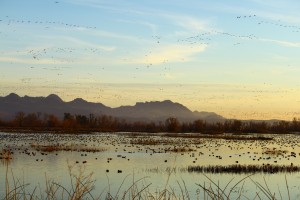Bird watcher, naturalist, and busily retired American Studies professor from the University of California, Davis, David Wilson has been a solid citizen of Chico and environs for more than two decades now. He is currently at work on a collection of essays, poems, maps, and sketches that chronicle his journey from Minnesota boyhood to a new life in California’s great valley. We excerpt part of that book here.—Editor
Any place is more than just material objects, landscapes, and homescapes. Things carry names as part of the history of a region. Names give meaning to the raw data of dirt, streams, weeds, and animals in a particular place, and especially to the integration of things. Layers of namescapes cover any landscape.
Common names like “blackbird” or “poison oak,” “sparrow“ or “weed” may suit a population of adults and children who participate in everyday interactions with nature more or less absentmindedly, uncritically. Similarly, “proper common names” for birds, like Brewer’s blackbird, Anna’s hummingbird, white-crowned sparrow, turkey vulture, and yellow-billed magpie, realize a web of names approved by the American Ornithological Union (AOU) that articulate a specialized taxonomy of place.
But names are not the things and cannot substitute for real birds or plants.
Even so, getting the names right may accomplish part of the mission of an immigrant making a home in the Valley.
Of course, common names taken for granted in one climate may also mislead nature lovers in a new setting. Our blue birds and blue jays, for example, do not look or act or sound much like blue birds and blue jays east of the Sierra. Our so-called scrub jay’s name is not meant to demean the species but to refer to its habitat.
Nevertheless, anyone trying to become at home in this valley might well adopt a bird species or plant species and then learn everything about it from books, from Google, from monographs and images, from poems and from folklore and even from extravagant yarns: consider the wonderfully funny “Baker’s Buejay Yarn” by Mark Twain:
Baker said that after long and careful observation, he had come to the conclusion that the bluejays were the best talker he had found among birds and beasts. Said he: “There’s more to a bluejay than any other creature. He has got more moods, and more different kinds of feelings than other creatures; and, mind you, whatever a bluejay feels he can put into language. And no mere commonplace language, either, but rattling, out-and-out book talk—and bristling with metaphor, too—just bristling.”
West of the Sierra Nevada scrub jays are more raucous and pushy than jays back east, and not handsome in the way that eastern blue jays native to the Midwest are. Scrub jays speak Central Valley. Hear Storer and Usinger (Sierra Nevada Natural History) on the talk and posturing of our jays:
This avian busybody of the foothill oaks is easy to see and hear. Often it perches alertly with feet spread, head up, and tail level or tilted upward; again it will sit motionless for minutes with the tail hanging vertically. Being bold and curious, it watches all local events and is quick to dash off in noisy flight and investigate. If an owl or other predator is sighted, the bird’s excited calls promptly bring others of the species. The varied “vocabulary” evidently is meaningful to others of the species.
The wit and poetry packed into the names of things draw me on as an explorer myself. Who discovered and named the animals and plants for us and how does all that fit into the story of flora and fauna in the Valley?
I ponder this question, again, as I head again into the Sutter Buttes. Occasionally I lead hikers intrigued by the flora and fauna and geology of the Sutter Buttes, “Smallest Mountain Range in the World,” as a guide for the Middle Mountain Foundation, a nonprofit assembly of citizens, ranchers, neighbors, and naturalists whose aim is to appreciate and cherish this unique remnant of nature and earlier ranching ways now surrounded by the modern agricultural and urban development of northern California.
The importance of the Buttes to me and to my discernment of the special iconic quality of the place began in 1983 as I traveled north to Chico from Davis. At first the hyperbolic epithet, “smallest mountain range in the world,” struck me as typical American hype. But as I drove by on the west side one day the Buttes became a background for the nearer farming scenes of drained rice “paddies” and standing farming machinery in the foreground. When I drove by on the east, the Buttes served as background for the dome of the Sikh Gudwara, and I caught a glimpse of the special spiritual centering the Buttes exemplify.
 When one Saturday I at last entered Peace Valley in the Buttes, I felt embraced by the landscape between the Buttes’ “castellated core” and “ramparts,” descriptive tropes applied to features of the Buttes by Howell Williams, whose pioneering geological monograph first described the Buttes for fellow geologists. He saw the Buttes as an arrangement of core, moat, and ramparts resulting from the uplift of valley floor by intrusive volcanic events a million and a half years ago. Seen from the outside, the Buttes display profiles of a lumpy landscape with several peaks. Seen from above, as we today may see from an airplane and as Williams imagined them, we are startled to find them an almost perfect, ten-mile-in-diameter, circular landscape feature, a mandala, as it were.
When one Saturday I at last entered Peace Valley in the Buttes, I felt embraced by the landscape between the Buttes’ “castellated core” and “ramparts,” descriptive tropes applied to features of the Buttes by Howell Williams, whose pioneering geological monograph first described the Buttes for fellow geologists. He saw the Buttes as an arrangement of core, moat, and ramparts resulting from the uplift of valley floor by intrusive volcanic events a million and a half years ago. Seen from the outside, the Buttes display profiles of a lumpy landscape with several peaks. Seen from above, as we today may see from an airplane and as Williams imagined them, we are startled to find them an almost perfect, ten-mile-in-diameter, circular landscape feature, a mandala, as it were.
Modern students of this valley island have learned that our predecessors here had regarded the Buttes as sacred and as shared territory long before Spanish, Mexican, and American invaders “swarmed into the Sacramento Valley,” as Walt Anderson puts it in his Inland Island: The Sutter Buttes:
With respect to our modern Sutter Buttes, the Maidu Indians called the circular ring of stone Esto-Busin-Yamani, Middle-Mountain-Lodge. The translation is more accurately rendered as Mountain Dance Lodge in the Center, important as the name clearly identifies the Buttes as the primal prototype of the most sacred center of religious life, the dance lodge.
These natives did not live in the Buttes, but in the lands around, coming into the Buttes for sacred ceremonies and to harvest acorns, as testified to by the numerous bedrock mortars where acorns were pounded into flour. We later arrivals who love the Buttes similarly go into the center for nourishment and refreshment, perspective, and reverence of creation.
The Buttes mean different things to different folks. They are grazing land for sheep ranchers, ranchland for cattle ranchers, and icons of place for citizens who embrace The Buttes on signs, murals, placemats, and mastheads for local newspapers. They even offer a useful response to urban insult. When more than two decades ago Rand-McNally ranked nearby Marysville/Yuba City dead last in a long list of congenial communities in which to live, they galvanized local pride in the form of bumper stickers, T-shirts and tractor caps announcing Rand McNally, Kiss My Buttes and Up Your Atlas, Rand McNally!
To me the Buttes mean a coherence of nature, of land use, of flora and fauna and of the dedicated attempts of locals to take care of and cherish the mandala around which we live. The spirit of the place – its true name – remains unchanged.
Citizens from surrounding farms and foothills often fix on the Buttes as a signpost of familiar territory, as in: “When I see the Sutter Buttes I know I am almost home.” So do I.
Photos by Karen Laslo. Top: Scrub jay. Bottom: The Sutter Buttes in December.



Names and True Names
Bird watcher, naturalist, and busily retired American Studies professor from the University of California, Davis, David Wilson has been a solid citizen of Chico and environs for more than two decades now. He is currently at work on a collection of essays, poems, maps, and sketches that chronicle his journey from Minnesota boyhood to a new life in California’s great valley. We excerpt part of that book here.—Editor
Any place is more than just material objects, landscapes, and homescapes. Things carry names as part of the history of a region. Names give meaning to the raw data of dirt, streams, weeds, and animals in a particular place, and especially to the integration of things. Layers of namescapes cover any landscape.
Common names like “blackbird” or “poison oak,” “sparrow“ or “weed” may suit a population of adults and children who participate in everyday interactions with nature more or less absentmindedly, uncritically. Similarly, “proper common names” for birds, like Brewer’s blackbird, Anna’s hummingbird, white-crowned sparrow, turkey vulture, and yellow-billed magpie, realize a web of names approved by the American Ornithological Union (AOU) that articulate a specialized taxonomy of place.
But names are not the things and cannot substitute for real birds or plants.
Even so, getting the names right may accomplish part of the mission of an immigrant making a home in the Valley.
Of course, common names taken for granted in one climate may also mislead nature lovers in a new setting. Our blue birds and blue jays, for example, do not look or act or sound much like blue birds and blue jays east of the Sierra. Our so-called scrub jay’s name is not meant to demean the species but to refer to its habitat.
Nevertheless, anyone trying to become at home in this valley might well adopt a bird species or plant species and then learn everything about it from books, from Google, from monographs and images, from poems and from folklore and even from extravagant yarns: consider the wonderfully funny “Baker’s Buejay Yarn” by Mark Twain:
Baker said that after long and careful observation, he had come to the conclusion that the bluejays were the best talker he had found among birds and beasts. Said he: “There’s more to a bluejay than any other creature. He has got more moods, and more different kinds of feelings than other creatures; and, mind you, whatever a bluejay feels he can put into language. And no mere commonplace language, either, but rattling, out-and-out book talk—and bristling with metaphor, too—just bristling.”
West of the Sierra Nevada scrub jays are more raucous and pushy than jays back east, and not handsome in the way that eastern blue jays native to the Midwest are. Scrub jays speak Central Valley. Hear Storer and Usinger (Sierra Nevada Natural History) on the talk and posturing of our jays:
This avian busybody of the foothill oaks is easy to see and hear. Often it perches alertly with feet spread, head up, and tail level or tilted upward; again it will sit motionless for minutes with the tail hanging vertically. Being bold and curious, it watches all local events and is quick to dash off in noisy flight and investigate. If an owl or other predator is sighted, the bird’s excited calls promptly bring others of the species. The varied “vocabulary” evidently is meaningful to others of the species.
The wit and poetry packed into the names of things draw me on as an explorer myself. Who discovered and named the animals and plants for us and how does all that fit into the story of flora and fauna in the Valley?
I ponder this question, again, as I head again into the Sutter Buttes. Occasionally I lead hikers intrigued by the flora and fauna and geology of the Sutter Buttes, “Smallest Mountain Range in the World,” as a guide for the Middle Mountain Foundation, a nonprofit assembly of citizens, ranchers, neighbors, and naturalists whose aim is to appreciate and cherish this unique remnant of nature and earlier ranching ways now surrounded by the modern agricultural and urban development of northern California.
The importance of the Buttes to me and to my discernment of the special iconic quality of the place began in 1983 as I traveled north to Chico from Davis. At first the hyperbolic epithet, “smallest mountain range in the world,” struck me as typical American hype. But as I drove by on the west side one day the Buttes became a background for the nearer farming scenes of drained rice “paddies” and standing farming machinery in the foreground. When I drove by on the east, the Buttes served as background for the dome of the Sikh Gudwara, and I caught a glimpse of the special spiritual centering the Buttes exemplify.
Modern students of this valley island have learned that our predecessors here had regarded the Buttes as sacred and as shared territory long before Spanish, Mexican, and American invaders “swarmed into the Sacramento Valley,” as Walt Anderson puts it in his Inland Island: The Sutter Buttes:
With respect to our modern Sutter Buttes, the Maidu Indians called the circular ring of stone Esto-Busin-Yamani, Middle-Mountain-Lodge. The translation is more accurately rendered as Mountain Dance Lodge in the Center, important as the name clearly identifies the Buttes as the primal prototype of the most sacred center of religious life, the dance lodge.
These natives did not live in the Buttes, but in the lands around, coming into the Buttes for sacred ceremonies and to harvest acorns, as testified to by the numerous bedrock mortars where acorns were pounded into flour. We later arrivals who love the Buttes similarly go into the center for nourishment and refreshment, perspective, and reverence of creation.
The Buttes mean different things to different folks. They are grazing land for sheep ranchers, ranchland for cattle ranchers, and icons of place for citizens who embrace The Buttes on signs, murals, placemats, and mastheads for local newspapers. They even offer a useful response to urban insult. When more than two decades ago Rand-McNally ranked nearby Marysville/Yuba City dead last in a long list of congenial communities in which to live, they galvanized local pride in the form of bumper stickers, T-shirts and tractor caps announcing Rand McNally, Kiss My Buttes and Up Your Atlas, Rand McNally!
To me the Buttes mean a coherence of nature, of land use, of flora and fauna and of the dedicated attempts of locals to take care of and cherish the mandala around which we live. The spirit of the place – its true name – remains unchanged.
Citizens from surrounding farms and foothills often fix on the Buttes as a signpost of familiar territory, as in: “When I see the Sutter Buttes I know I am almost home.” So do I.
Photos by Karen Laslo. Top: Scrub jay. Bottom: The Sutter Buttes in December.